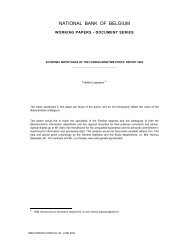A multi-factor model for the valuation and risk management of ...
A multi-factor model for the valuation and risk management of ...
A multi-factor model for the valuation and risk management of ...
Create successful ePaper yourself
Turn your PDF publications into a flip-book with our unique Google optimized e-Paper software.
estimated). Corresponding tables with <strong>the</strong> parameter estimates <strong>for</strong> <strong>the</strong> 1 <strong>and</strong> 2 term structure<br />
<strong>factor</strong> <strong>model</strong> are presented in an Appendix.<br />
Let us compare <strong>the</strong> quality <strong>of</strong> <strong>the</strong> …t <strong>of</strong> <strong>the</strong> di¤erent single- <strong>and</strong> <strong>multi</strong>ple term structure <strong>factor</strong><br />
<strong>model</strong>s. Figure 3 plots <strong>the</strong> …t <strong>of</strong> <strong>the</strong> observed average yield curve (<strong>the</strong> corresponding numbers can<br />
also be retrieved from <strong>the</strong> …rst columns <strong>of</strong> Table 7). Except <strong>for</strong> <strong>the</strong> short end, <strong>the</strong> 1-<strong>factor</strong> <strong>model</strong><br />
is unable to closely …t <strong>the</strong> observed average yield curve. The 2-<strong>factor</strong> <strong>model</strong> already per<strong>for</strong>ms<br />
remarkably better, but it is <strong>the</strong> 3-<strong>factor</strong> <strong>model</strong> that results in a …t <strong>of</strong> <strong>the</strong> average yield curve<br />
that is visually almost indiscernible from <strong>the</strong> actual sample statistics. This is also apparent from<br />
Table 7. Means <strong>and</strong> volatilities are typically …tted with an accuracy <strong>of</strong> about 1 or 2 basis points<br />
in <strong>the</strong> 3-<strong>factor</strong> yield curve <strong>model</strong>, while <strong>the</strong> …tting errors become an order <strong>of</strong> magnitude larger<br />
<strong>for</strong> <strong>the</strong> 2-<strong>factor</strong> <strong>and</strong> 1-<strong>factor</strong> <strong>model</strong>s. Figure 4 plots <strong>the</strong> …t <strong>of</strong> selected yields at each data point,<br />
instead <strong>of</strong> <strong>the</strong> …t <strong>of</strong> <strong>the</strong> average yield curve. From this Figure, it is clear that <strong>the</strong> 3-<strong>factor</strong> <strong>model</strong><br />
outper<strong>for</strong>ms <strong>the</strong> 2-<strong>factor</strong> <strong>model</strong>, which in turn outper<strong>for</strong>ms <strong>the</strong> 1-<strong>factor</strong> <strong>model</strong>. The single-<strong>factor</strong><br />
<strong>model</strong> per<strong>for</strong>ms particularly bad at <strong>the</strong> long end <strong>of</strong> <strong>the</strong> yield curve, <strong>and</strong> long yields are <strong>of</strong>ten underor<br />
overestimated by more than 100 basis points. As our main aim is a realistic simulation <strong>of</strong> interest<br />
rates over a long horizon, we will retain <strong>the</strong> 3-<strong>factor</strong> <strong>model</strong> estimates <strong>for</strong> our benchmark simulation<br />
results.<br />
Table 7: Comparison …tted average <strong>and</strong> volatility <strong>of</strong> yields across di¤erent <strong>multi</strong><strong>factor</strong><br />
term structure <strong>model</strong>s<br />
Mean<br />
Volatility<br />
Data 1f-<strong>model</strong> 2f-<strong>model</strong> 3f-<strong>model</strong> Data 1f-<strong>model</strong> 2f-<strong>model</strong> 3f-<strong>model</strong><br />
yield 1m 3.236 3.242 3.228 3.250 0.932 0.947 0.944 0.932<br />
yield 2m 3.263 3.262 3.261 3.262 0.946 0.947 0.947 0.946<br />
yield 3m 3.278 3.283 3.295 3.277 0.956 0.947 0.949 0.960<br />
yield 6m 3.325 3.345 3.391 3.331 0.997 0.947 0.959 0.999<br />
yield 1yr 3.471 3.468 3.571 3.474 1.079 0.947 0.983 1.058<br />
yield 2yr 3.801 3.713 3.883 3.800 1.143 0.947 1.039 1.114<br />
yield 3yr 4.106 3.957 4.148 4.106 1.137 0.947 1.089 1.136<br />
yield 4yr 4.364 4.199 4.376 4.366 1.152 0.947 1.129 1.149<br />
yield 5yr 4.581 4.439 4.577 4.582 1.156 0.947 1.158 1.160<br />
yield 10yr 5.214 5.615 5.306 5.216 1.197 0.947 1.198 1.189<br />
All table entries are annualized <strong>and</strong> expressed in percentage points. Column headings "1f-<strong>model</strong>", "2f-<strong>model</strong>", <strong>and</strong><br />
"3f-<strong>model</strong>" refer to <strong>the</strong> <strong>model</strong>s with 1, 2, <strong>and</strong> 3 term structure <strong>factor</strong>s respectively.<br />
Figure 5 plots <strong>the</strong> loading vectors b () = <strong>for</strong> <strong>the</strong> <strong>factor</strong>s in <strong>the</strong> 1-, 2-, <strong>and</strong> 3-<strong>factor</strong> <strong>model</strong>s. Factor<br />
1, f 1 (t), can be labelled a "level <strong>factor</strong>" as it shifts <strong>the</strong> entire yield curve approximately in a parallel<br />
way when it moves up or down. Factors 2 <strong>and</strong> 3, f 2 (t) <strong>and</strong> f 3 (t), resemble "slope <strong>factor</strong>s" as <strong>the</strong>y<br />
shift <strong>the</strong> short end <strong>of</strong> <strong>the</strong> yield curve up or down, while having a smaller impact on <strong>the</strong> long end<br />
<strong>of</strong> <strong>the</strong> yield curve.<br />
Table 8 compares <strong>the</strong> explanatory power <strong>of</strong> <strong>the</strong> di¤erent <strong>factor</strong>s in <strong>the</strong> di¤erent <strong>model</strong>s. While <strong>the</strong><br />
single term structure <strong>factor</strong> in <strong>the</strong> 1-<strong>factor</strong> term structure <strong>model</strong> explains on average only 57.7%<br />
<strong>of</strong> total variability in yields, <strong>the</strong> three term structure <strong>factor</strong>s taken toge<strong>the</strong>r explain on average<br />
99.4% <strong>of</strong> total yield variability.<br />
Figure 6 plots …tting errors <strong>for</strong> <strong>the</strong> deposit rates under consideration. Fitted deposit rates are<br />
almost identical, irrespective <strong>of</strong> whe<strong>the</strong>r we are using a single- or <strong>multi</strong>-<strong>factor</strong> yield curve <strong>model</strong>.<br />
Fitting errors are relatively large overall <strong>and</strong> remarkably larger <strong>for</strong> <strong>the</strong> medium-sized banks. Figure<br />
7 plots <strong>the</strong> loadings on <strong>the</strong> deposit spread <strong>factor</strong>. It turns out that <strong>the</strong> loadings do not di¤er<br />
dramatically across banks <strong>and</strong> across di¤erent <strong>multi</strong>-<strong>factor</strong> <strong>model</strong>s, implying that <strong>the</strong>re is a large<br />
amount <strong>of</strong> comovement in deposit rates across banks. Table 9 reports <strong>the</strong> explanatory power <strong>of</strong> <strong>the</strong><br />
(priced) term structure <strong>factor</strong>s as a percentage <strong>of</strong> total deposit rate variability. It turns out that<br />
<strong>the</strong> term structure <strong>factor</strong>s explain on average 47%, 54%, <strong>and</strong> 54% <strong>of</strong> <strong>the</strong> total variability in deposit<br />
14
















